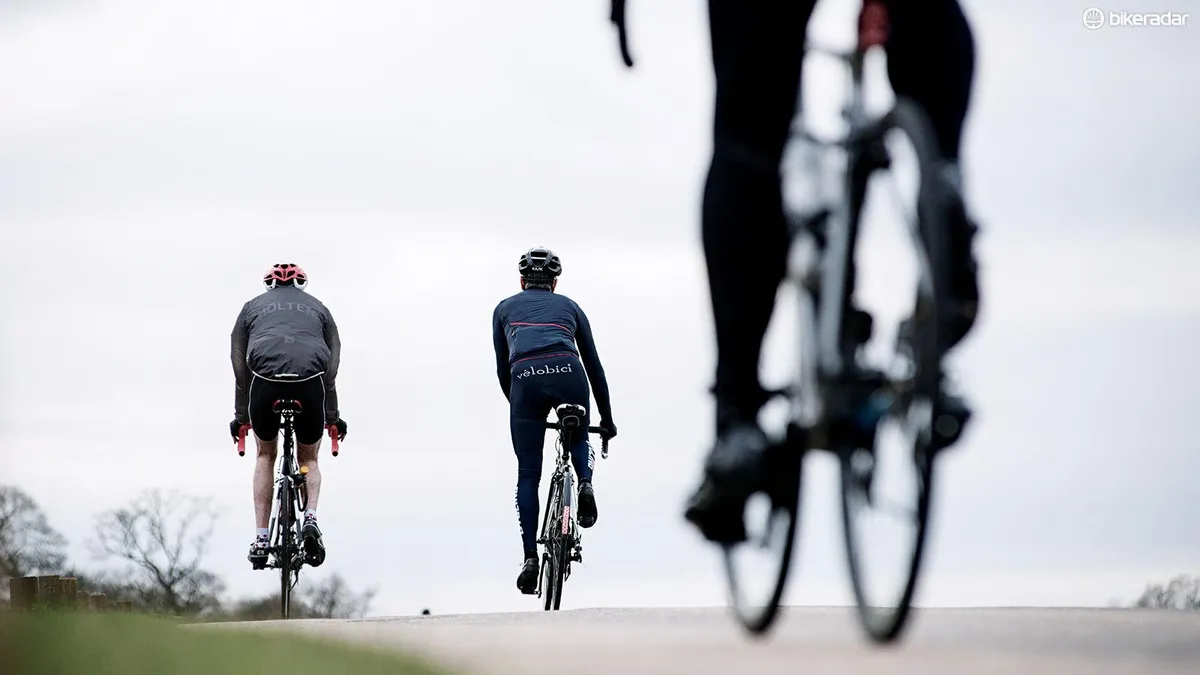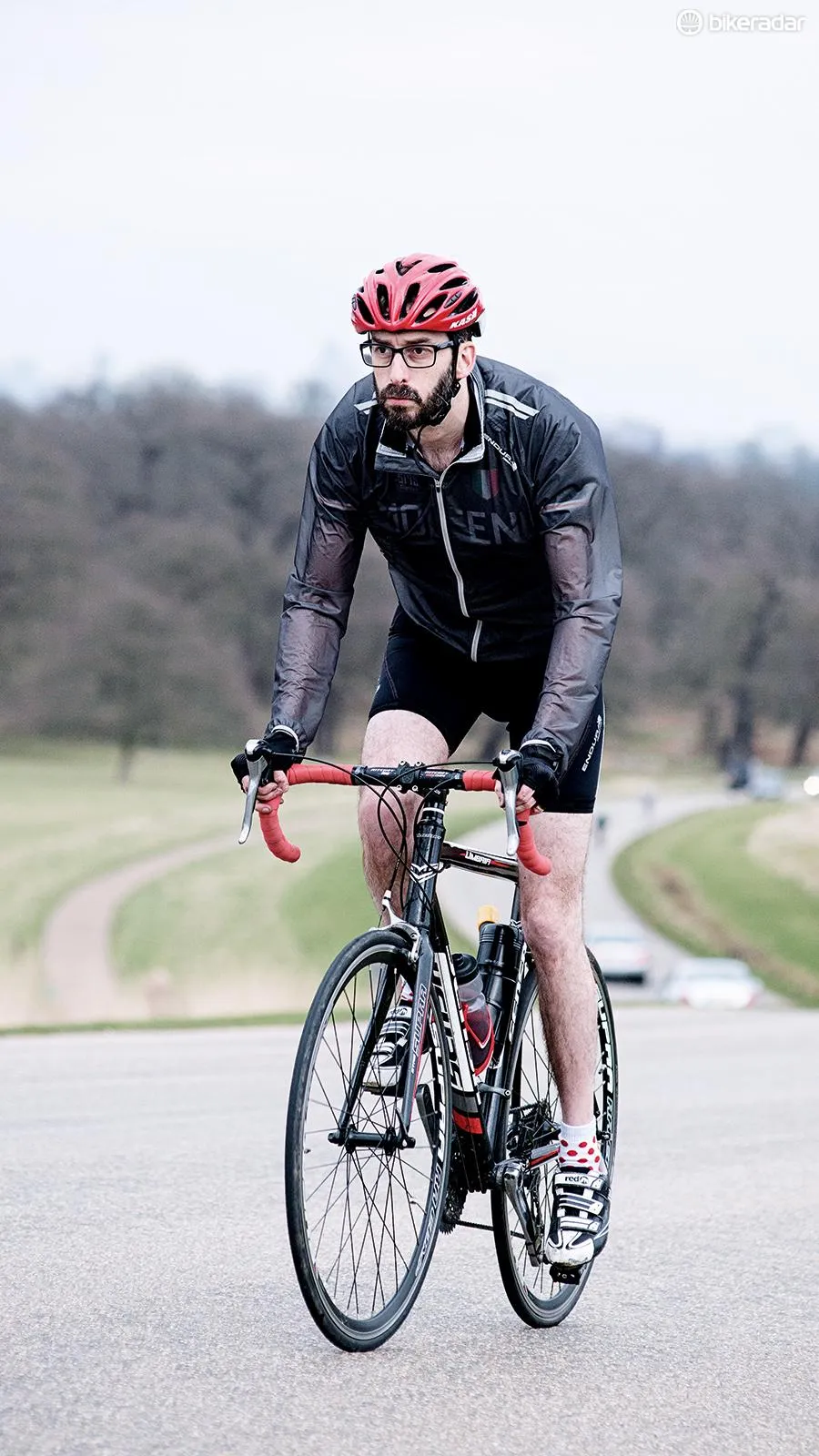To sit or to stand when faced with a climb is a dilemma as old as riding a bike, but which method is best when the road points up? We look to science for some answers...
Some aspects of riding a bike are instinctive. Long before you wore Lycra or rode in the drops, probably as far back as when you still had streamers on your handlebar, you hit your first hill and automatically rose out of the saddle to make the climb easier...
It’s a regular source of debate among cyclists, with some believing that seated climbing is the best way to conserve energy, and others suggesting that the greater speed and muscle recruitment of standing makes it worth a little extra energy expenditure.
My natural inclination is to ride in the saddle, so out of curiosity I do my first run standing
To test the arguments, we’re equipped with a heart rate monitor, a powermeter and a comparatively modest hill, we’re going to carry out widely separated rides and have the data interpreted by a coach and a physiologist.
The hill will be ridden twice — once seated, once standing. It’s 700 yards long and around four percent average gradient. Although those numbers don’t approximate monster climbs, it has been carefully chosen by Paul Hough, lead physiologist at St Mary’s University Twickenham.
The gradient needs to be such that a rider has a genuine choice about whether to ride seated or standing, and long enough to overcome pulse lag without being too long to be practical for an out-of-the-saddle effort.
Our guinea pigs have been chosen with equal care. I’m a survival-minded cyclist, who climbs from the saddle with the aim of preserving my strength to finish the ride, Togo Keynes is a British Cycling accredited coach whose company, Njinga, helps riders prepare for events like the Maratona dles Dolomites, and Cycling Plus deputy editor Paul Robson is an accomplished climber, a cingles du Ventoux (three ascents of Mont Ventoux in a day), whose approach to the hills is defined more by panache than pragmatism: “I do most of my climbing out of the saddle. It looks cool, and when I was growing up Miguel Indurain rode in the saddle and Claudio Chiappucci often liked to get out of the saddle, and I wanted to be Chiappucci.”
Full-on and flat out
We’ve been instructed to ride flat out from start to finish, with a rolling start before the effort begins. My natural inclination is to ride in the saddle, so out of curiosity I do my first run standing.
The smooth acceleration that comes from propelling a high gear at a slightly lower cadence gives a sense of great power for very little effort, and I briefly wonder if I’m about to be converted to out-of-the-saddle climbing. Then, about a third of the way through, that familiar feeling appears; a tiredness in the full length of both thigh muscles.

When climbing in the saddle I find that the feeling of fatigue moves to a different part of the muscle at a different part of the pedal stroke, providing a constant cycle of respite.
By the time I’m halfway thorough this standing climb, there’s no respite — both my thighs are enveloped in a dull ache. As I crest the steepest part my speed has plummeted, and during the final approach to our finishing tape my efforts are as much mental as physical — I have to force myself not to sit.
That 700-yard climb takes a ridiculous 2min 40sec with an average heart rate of 149bpm and power output of 226 watts. What’s striking are the dynamics — from an initial high pace to a finishing crawl.
It has become common during these experiments for Paul to instantly put my efforts in the shade, which he promptly does with a 1.55 ride at an average of 331 watts and 149bpm.

Togo smashes the pair of us in 1:43, 420 watts, 144bpm. I console myself that they both rode seated climbs, and that my turn will come. Science, as it so often does, will strip away that comforting delusion.
The day has warmed up when we make our second rides. In my preferred seated position the climb is significantly easier, 18 seconds faster, and feels like something I could happily do all day, despite a higher average heart rate of 170bpm and 244 watts.
Paul’s effort takes him 1:54 at 157 average bpm and 342 watts, and Togo comes in at 1:49, 141bpm and 432 watts average. Armed with pages of numbers, we head to the lab.
Welcome to the glasshouse

The performance lab at St Mary’s puts those efforts into perspective. A sealed room to our right can simulate up to 5,000m of altitude and temperatures of up to 45 degrees. It’s one of the most advanced environment chambers in the UK and it’s currently being used to prep runners for the crushing 40-degree temperatures of the Marathon des Sables. I feel a tad sheepish telling Paul Hough that my legs hurt a bit when I’m out of the saddle.
“It’s clear from the fact that you took 18 seconds longer and rode at 18 watts lower that you’re not used to standing climbs. The other riders were able to transition more comfortably, as both of their times were relatively consistent: Paul varied by one second and Togo by six.”
Purely in terms of time, the three of us all did our fastest ride in our preferred position, Togo and I seated, Paul standing, and I ask Hough if habituation is a significant factor.
“This experiment shows that cyclists who habitually use a certain climbing style will invariably perform better using that style. However, like any skill, with practice it is possible to improve your ‘weaker’ position.

"Developing both techniques allows you to alternate between seated and standing cycling, which is beneficial from a musculoskeletal perspective. Standing allows you to lengthen the lower back and hip flexor muscles, both of which can become tight during a long ride. Standing also allows greater drive from the gluteal muscles, which can become de-conditioned in cyclists. Additionally, being able to climb standing allows you to be more reactive to changes in peloton dynamics.”
Togo, despite being pro-seated, agrees with the suggestion that being able to follow a group is vital, recounting how he frequently went into the red to stick with a group during a big sportive: “I went into zone four, but I’m staying with guys that are helping me the rest of the time. I’m slightly out of my zone, but I’m only doing it every fifth minute, and it’s worth it to stick with those guys. That’s the benefit of riding in a peloton.
"The flip side is that if you’re not an experienced rider you tend to mess your pedal technique up. You become a stomper, you use your quads rather than leaning the body forward and pulling the pedals forward. If you don’t have clipless or straps you’re up sh*t creek, because then you can only stomp.
“Also, I see a lot of people get out of the saddle because they’re impatient or can’t cope, because they can’t tolerate the pressure seated nine out of 10 times!”
Psychological factor
“A study conducted in the 1990s among trained cyclists indicated that standing is less economical during moderate climbs,” says Hough, “but standing results in a decreased perception of effort in the legs during steep climbs. This means there is a trade-off between metabolic and perceptual fatigue.
"In layman’s terms, if your legs feel fatigued and you’re approaching a short climb, standing might be the better option even though it might be more inefficient from a physiological perspective.”
A rider who is focused on reducing body fat would benefit from standing more often from an energetic perspective
Psychology, habituation and personal preference all play their part, but in the end the primary factor is efficiency: “Standing increases stress on the cardiovascular system, as you have to produce more force and thus expend more energy to support your body mass. Intuitively, this means standing climbing is less efficient. Efficiency isn’t always reduced when standing, as the rider usually produces more power, but is dependent on the length and severity of the climb and level of fitness.
“Developing standing technique can be beneficial for shorter, steeper climbs. Standing allows you to recruit core body musculature and use fast-twitch muscle fibres, both of which increase momentum and average power. But fast-twitch fibres fatigue quickly and the added contribution of force from extra muscle groups increases cardiovascular stress, which is why riders don’t use this hard and fast approach on long climbs, unless starting a breakaway.”
Finally, Hough points out that your goals and timing are a factor. Surviving a long, hilly sportive might mean using energy-efficient seated climbing, but you might still find it beneficial to stand during your training.
“A rider who is focused on reducing body fat would benefit from standing more often from an energetic perspective,” he explains, “as they would burn more calories during the ride and induce a greater energy deficit. This is why spin classes implement a lot of standing.”
This feature is supported by Velothon Wales



